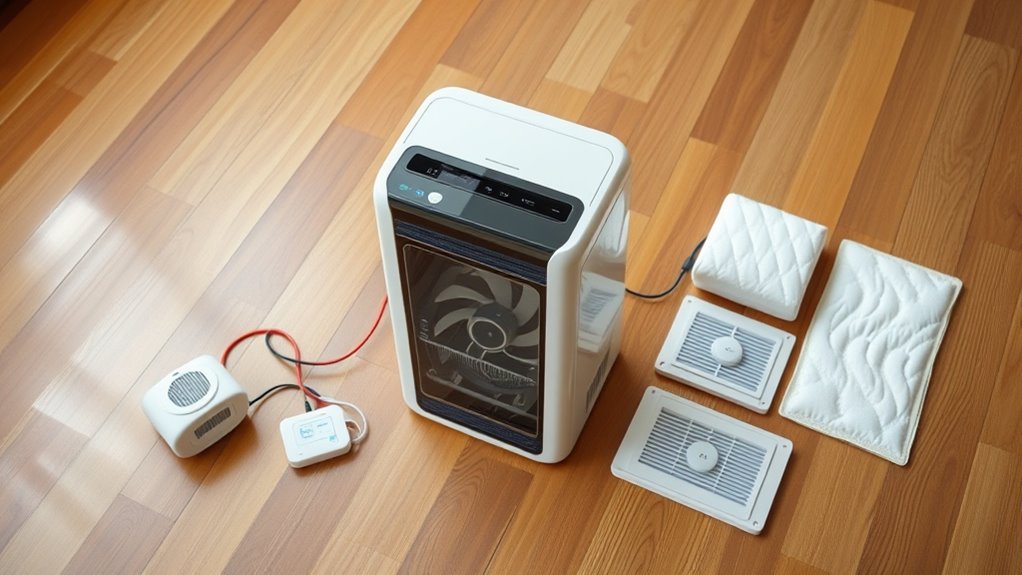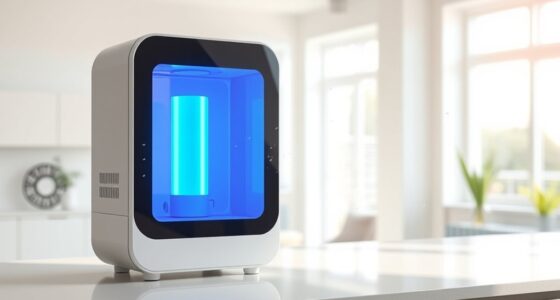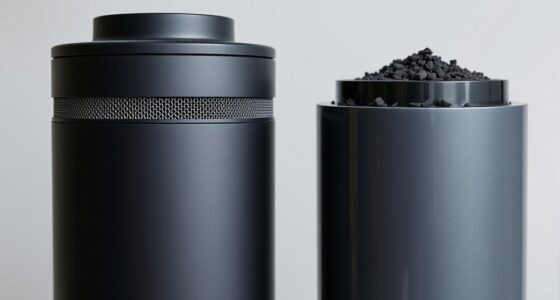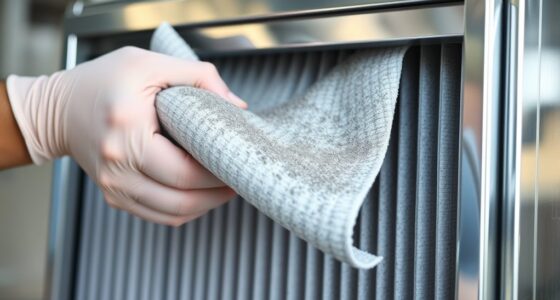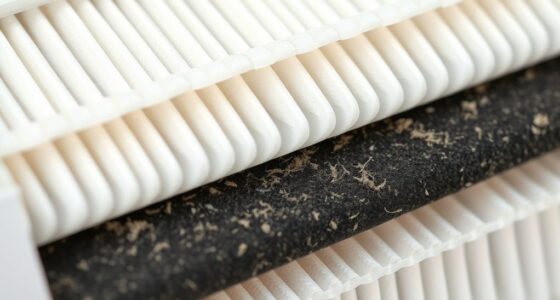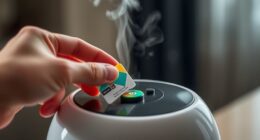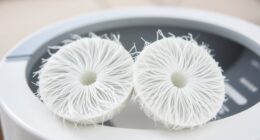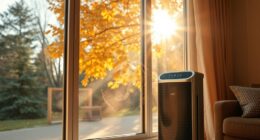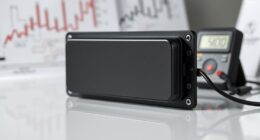Humidity sensors connect directly with dehumidifier accessories to provide real-time moisture data. When the sensor detects high humidity, it sends signals that trigger the dehumidifier to turn on or adjust its operation accordingly. This seamless communication creates an automated system that maintains ideal indoor conditions. Proper integration guarantees energy efficiency and prevents unnecessary equipment use. To discover how this setup works and improve your system, there’s more to explore beyond this overview.
Key Takeaways
- Humidity sensors send real-time moisture data to dehumidifier controllers for precise operation adjustments.
- Sensors communicate directly with dehumidifier accessories, enabling automatic activation or deactivation based on humidity levels.
- Integration involves firmware or software that interprets sensor signals to optimize dehumidifier performance.
- Smart sensors establish a feedback loop, allowing dehumidifiers to respond dynamically to environmental changes.
- Proper calibration and compatibility ensure sensors effectively trigger accessories, maintaining stable indoor humidity.
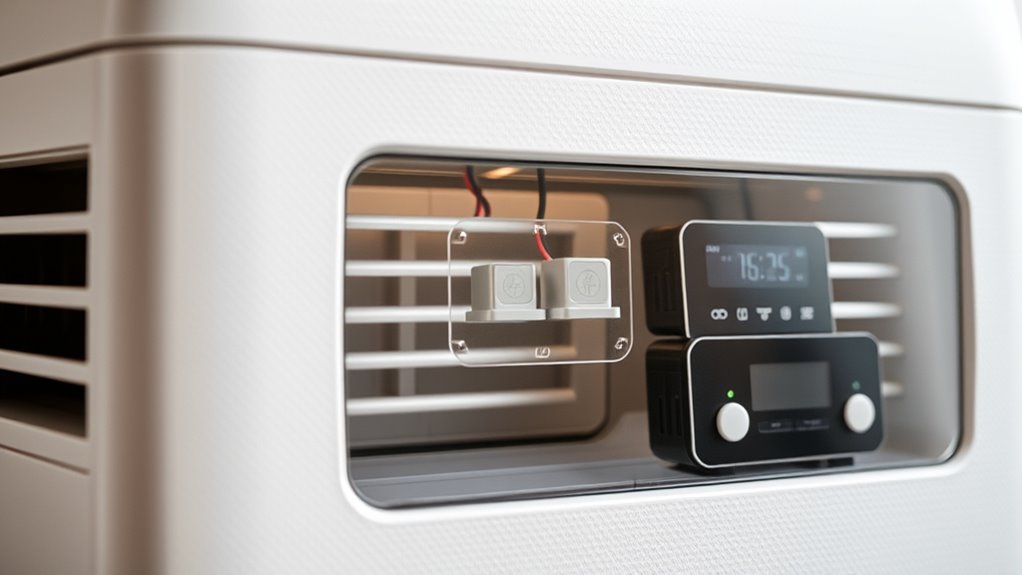
Humidity sensors and dehumidifier accessories play a crucial role in maintaining ideal indoor air quality and comfort. When you’re dealing with humidity control, accurate sensor calibration becomes essential because it ensures your humidity readings are precise. Proper calibration means the sensor correctly detects moisture levels, preventing your dehumidifier from overworking or underperforming. If your sensor isn’t calibrated properly, it might give false readings, causing your system to run unnecessarily or fail to respond when needed. Regular calibration helps keep your humidity levels stable, which not only boosts comfort but also enhances energy efficiency. When your dehumidifier operates based on accurate data, it uses power more effectively, avoiding wasteful cycles and reducing energy bills.
Integrating humidity sensors with dehumidifier accessories involves more than just plugging a device into the wall. Many modern systems feature smart sensors that communicate directly with the dehumidifier, creating a seamless feedback loop. This connection allows the equipment to adjust its operation dynamically, based on real-time humidity levels. For example, when the sensor detects high moisture content, the dehumidifier kicks in automatically, and when humidity drops to ideal levels, it powers down. This automation prevents unnecessary running time, which conserves energy and prolongs the lifespan of your equipment. You benefit from a more efficient system that responds precisely to your environment, saving you money and reducing your carbon footprint. Additionally, understanding local laws and regulations can help optimize your system’s compliance and efficiency.
Frequently Asked Questions
Can Humidity Sensors Be Used Outdoors Effectively?
Yes, humidity sensors can be used outdoors effectively if they have outdoor durability. To guarantee accurate readings, you should focus on proper sensor placement, avoiding direct sunlight and water exposure. Look for sensors designed with weather-resistant materials, and install them in shaded, protected areas to prevent damage. Proper placement and durable construction help you get reliable humidity data for outdoor environments.
How Often Should Humidity Sensors Be Calibrated?
You should calibrate your humidity sensor at least once a year to maintain ideal humidity accuracy. Regular sensor calibration ensures the readings stay precise, preventing issues like mold or excess dryness. If you notice inconsistent or unexpected humidity levels, calibrate it more frequently. Always follow the manufacturer’s instructions for calibration, and consider using a calibration kit for the most accurate results, especially if your sensor is exposed to harsh conditions.
Are There Wireless Options for Humidity Sensors?
Yes, wireless options for humidity sensors are readily available today, making your setup as flexible as a kite in the wind. These sensors often feature wireless connectivity, allowing you to monitor humidity levels remotely. Just guarantee they are compatible with your dehumidifier accessories, as sensor compatibility is key. With wireless humidity sensors, you can enjoy hassle-free installation and real-time updates, giving you better control over your environment.
Do Humidity Sensors Require Regular Maintenance?
Humidity sensors generally don’t require much maintenance, but you should follow a regular maintenance schedule to guarantee accuracy. Over time, sensor lifespan varies, and dust or dirt can affect readings. You might need to clean the sensor periodically using a soft cloth or compressed air. Keep an eye on the sensor’s performance, and replace it if readings become inconsistent or drift beyond acceptable limits to keep your dehumidifier functioning efficiently.
Can Humidity Sensors Detect Sudden Humidity Changes Accurately?
Yes, humidity sensors can detect sudden humidity changes accurately if they have good sensor accuracy and fast response time. High-quality sensors quickly pick up fluctuations, allowing your dehumidifier to respond promptly. Keep in mind that regular calibration and maintenance help maintain their accuracy and response time. With reliable sensors, you’ll experience precise humidity control, ensuring your environment stays comfortable and protected from excess moisture.
Conclusion
By integrating humidity sensors with dehumidifier accessories, you gain precise control over your environment. This seamless connection ensures ideal comfort and energy efficiency. Remember, “a stitch in time saves nine”—regularly monitoring with sensors prevents bigger issues down the line. Embrace these smart solutions, and you’ll create a healthier, more comfortable space with less effort. In the end, staying proactive today keeps problems at bay tomorrow.
